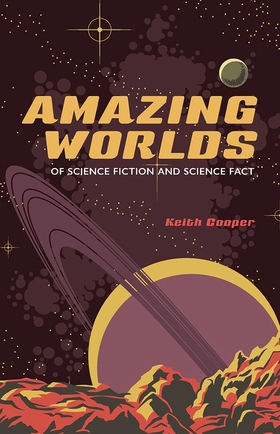Centauri Dreams
Imagining and Planning Interstellar Exploration
Alpha Centauri: Dust and Its Significance
When I was growing up, Alpha Centauri was utterly dismissed as a possible location for planets. A binary system couldn’t possibly produce them, I read, and it was assumed that planets could only be found around single stars like our own Sun. How times have changed. Now we know of plenty of multiple star systems with planets — the number is over ten percent of all known exoplanets — and while many of these are widely spaced, we’ve nonetheless found a few in tight circumstances indeed. HD196885 (Gamma Cephei) is an example, where the separation between the two stars is on the order of 20 AU, much like Centauri A and B.
How planets form around such stars is an interesting issue because, as a new paper considering dust in the Alpha Centauri system explains, the standard core-accretion model runs into problems with environments as perturbed as these. We can see the results in existing observations: Radial velocity methods detect no planets more massive than 2.5 Jupiter masses inside 4 AU of Centauri A or B, and large regions seem, from theoretical models, to be a real challenge to planet formation, with an outer limit for the process perhaps in the 2 AU region.
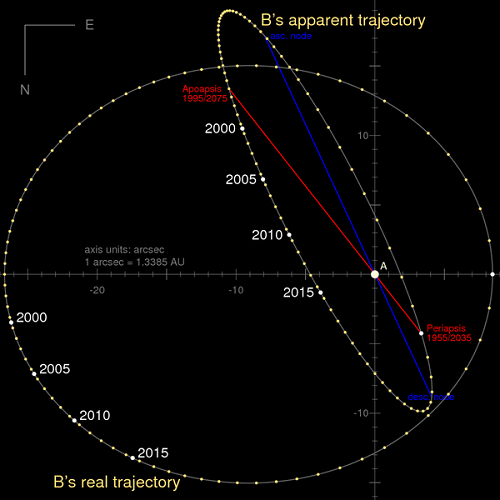
Image: Trajectory of Alpha Centauri B relative to A (fixed to the coordinate origin) as seen from the Earth (inclined ellipse) and face-on (horizontal ellipse). The orbit parameters are taken from Pourbaix et al. (2002). Credit: SiriusB/Wikimedia Commons.
What’s interesting about a new paper called “How dusty is α Centauri?” is that it gets into issues raised by the large number of planet-bearing stars known to show far-infrared emission from cool circumstellar dust. The authors, led by Joachim Wiegert (Onsala Space Observatory, Sweden), observed the Centauri stars to look for dust emissions there, presumably the results of collisions between objects up to planetesimal size. The team sought to understand the properties of the dust and to gauge the minimum temperature (Tmin) of the stellar chromospheres, a layer in the stars’ atmospheres that plays a role in how we determine the emission from cool dust in such systems.
The close-in Centauri stars, then, are templates that may help us find undetected dust disks around other stars. The team notes that it is::
…primarily concerned with the possible effects Tmin might have on the estimation of very low emission levels from exo-Edgeworth-Kuiper belt dust. The intensity of the stellar model photosphere beyond 20 to 40 µm is commonly estimated from the extrapolation of the spectral energy distribution (SED) into the Rayleigh-Jeans (RJ) regime at the effective temperature Teff. There is a potential risk that this procedure will overestimate actual local stellar emissions, which may be suppressed at the lower radiation temperatures. In those cases, where the SEDs are seemingly well fit by the RJ-extrapolations, the differences may in fact be due to emission from cold circumstellar dust (exo-Edgeworth-Kuiper belts) and, here, we wish to quantify the magnitude of such an effect.
As to Alpha Centauri itself, a slight infrared excess could be interpreted as dust emissions around both Centauri A and B. Disk modeling then produces the possibility of two circumstellar disks, the one around Centauri A being no larger than 2.78 ± 1.48 AU, while around Centauri B the limits are 2.52 ± 1.60 AU (the planet tentatively identified as Centauri Bb in 2012 is small enough and close enough to the star that it is inside the range of the authors’ disk models, and is thus ignored in their modelling). And while a circumbinary dust disk is possible at distances greater than 75 or so AU from the barycenter of the stars, no such disk was detected by these observations, and the authors note that other studies have made this scenario unlikely.
And this is interesting: “These size limits are reminiscent of the inner solar system, i.e., this opens the possibility for an asteroid belt-analogue for each star which forms dust discs through the grinding of asteroids and comets.” The results, displaying the possible disks and their snow lines, are shown in the figure below:
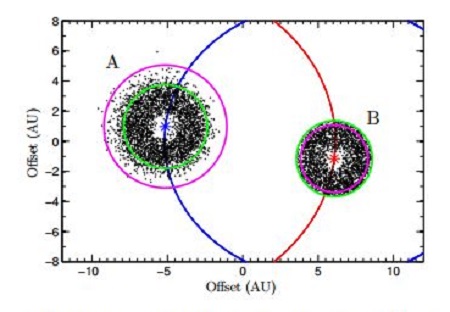
Image: Face-on circumstellar test-particle discs after ~ 103 periods shown with the stars close to periapsis. α Cen A is colour-coded blue (the left star and its orbit) and α Cen B is colour-coded red (the right star and its orbit). The green circles represent acrit around the stars and the magenta circles show estimates of their respective snow lines. Credit: Wiegert et al., taken from the paper.
We don’t yet know whether the excess at 24 µm the researchers found is a detection of warm dust or not — the paper describes the data as “marginal excesses” for both Centauri A and B, adding that “If due to circumstellar emission from dust discs, fractional luminosity and dust mass levels would be some 10 to 100 times those of the solar zodiacal cloud.” As we push deeper into the study of the nearest stars, we’ll use what we learn about dust emissions and their relation to stellar temperatures to study cool circumstellar disk possibilities around more distant targets.
The paper is Wiegert et al., “How dusty is α Centauri?” accepted at Astronomy & Astrophysics and available as a preprint. Thanks to Andy Tribick for the pointer to this one.

Habitability Around Ancient Stars
I see a lot to like about Abraham Loeb’s new paper “The Habitable Epoch of the Early Universe,” available as a preprint and now going through the submission process at Astrobiology. Not that it isn’t controversial, and for reasons that are patently obvious as soon as one digs into it. But the sheer chutzpah of postulating that microbial life might have started up no more than ten or fifteen million years after the Big Bang takes the breath away. This is a notion that extends life so far back that it defies our conventional models of how it formed.
Temperatures aren’t the problem, given that radiation in the early universe would have produced cozy conditions for a multi-million year window of time as what is now called the cosmic microwave background (CMB) continued to cool. The problem is that we have to get from hydrogen and the helium created by fusion in the Big Bang furnace to heavy elements that are usually explained by large stars seeding the cosmos with supernovae explosions. So we need to figure out whether or not such stars could have formed at this remarkably early epoch.
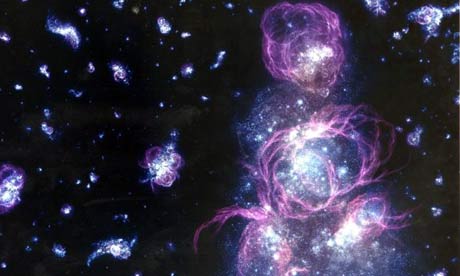
Image: An artist’s impression of how the very early universe might have looked as star formation began. Photograph: Adolf Schaller/AP.
Loeb argues that the first star-forming halos begin to collapse in this era. Certain density perturbations in this environment, rare but feasible, could have given birth to the stars we need, themselves the harbingers of the first rocky planets, which would have existed in a CMB radiation warm enough for liquid water to exist on their surface. Or as he puts it in the preprint:
Deviations from Gaussianity in the far (8.5?) tail of the probability distribution of initial density perturbations, could have led already at these redshifts to the birth of massive stars, whose heavy elements triggered the formation of rocky planets with liquid water on their surface. And even as the CMB continued to cool, the thermal gradients needed for life would still be created through geothermal energy as well as radioactive energies from unstable elements in the primordial supernovae. A blanket of molecular hydrogen could retain that warmth.
At a redshift of z ? 100, which Loeb regards as ‘the earliest cosmic epoch after which life was possible in our Universe,” we are dealing with a time when the universe was far denser than it is today, perhaps a million times as much, or approximately 1 hydrogen atom per cubic centimeter. This is typical of the average density of matter in galaxies, but imagine this density extended over the entire universe in that era. I should note that I’m drawing from Loeb here but also from Edward Harrison’s Cosmology: The Science of the Universe (Cambridge, 2000). When we go this far back, to a time 10 to 17 million years after the Big Bang, the cosmic microwave background has reached a temperature of 273-373 K (0-100 degrees Celsius).
The density issue is intriguing. A certain density of matter must exist within the universe to avoid a Big Crunch, with the entire cosmos falling back in on itself because of gravity, and recent work indicates that baryonic matter combined with still mysterious dark matter can account for 30 percent of that critical density. The balance is provided by a cosmological constant, an idea introduced by Einstein and later given punch by the discovery of cosmic acceleration in 1998.
It was back in 1987 that Stephen Weinberg argued that if the cosmological constant were just one order of magnitude larger than observed, stars would never form nor, obviously, would life. Loeb looks askance at that conclusion at the end of his paper, especially given the possibility that the amplitude of the initial density perturbations might have varied in different regions of the presumed multiverse. He makes the case that life could emerge with a cosmological constant that is (1 + z)3 ~ 106 bigger than observed. “The possibility of life starting when the average matter density was a million times bigger than it is today argues against the anthropic explanation for the low value of the cosmological constant.”
So we wind up with a new kind of habitable planet, one we are now considering for the first time. Yes, we can talk about liquid water on its surface, and we can throw in geothermal activity as well and radiogenic heating, but we might not need a star to nourish it given the help of the cosmic microwave background’s heat energy. As I say, it’s a fascinating concept, and one I don’t think I’ve run into in the most speculative science fiction. That situation should change soon enough as some talented practitioners of the trade get a close look at Loeb’s conclusions.

Starships: Sentient Habitats
Librarian and futurist Heath Rezabek has become a familiar figure on Centauri Dreams through his writings on existential risk and how our species might counter it through Vessels, installations conveying our planet’s biological and cultural identity. The Vessel concept is far-reaching, and if we build it on Earth, we would likely take it to the stars. But in what form, and with what purpose? Enter the lightsail starship mission Saudade 4, its crew — some of whom are humans by choice — nourished on the dreams of a continually growing archive. Heath’s chosen medium, the essay form morphing into fiction, conjures the journey star travelers may one day experience.
by Heath Rezabek

I’ve described The Vessel Project in four prior posts:
August 29, 2013 – Deep Time: The Nature of Existential Risk
October 3, 2013 – Visualizing Vessel
November 7, 2013 – Towards a Vessel Pattern Language
December 13, 2013 – Vessel: A Science Fiction Prototype
As I began preparing my paper on the Vessel project for the 2012 100YSS Symposium, one of the first things to occur to me was the potential crossover between the project’s goals and some of the functional requirements of a starship. While at heart a Vessel installation would be a comprehensive archive, the capacity of such a thing suggested so much more. I’ll explore these other facets through essay and fiction in coming installments.
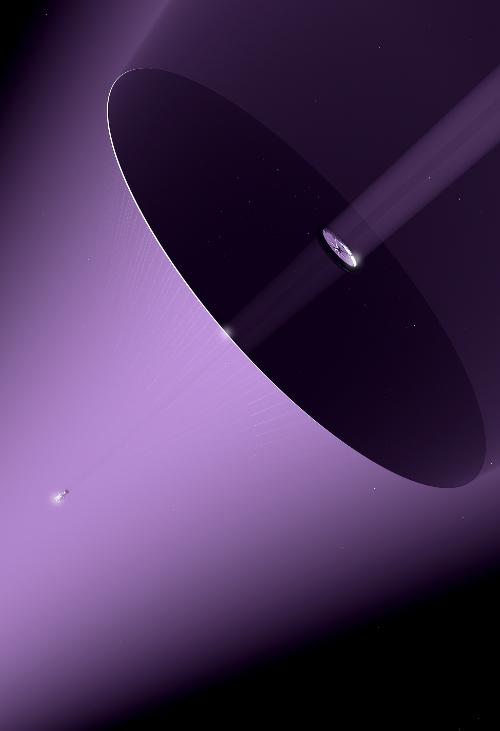
Figure 1: Sailship – Adrian Mann (Used by Permission).
Providing a guiding intelligence for a starship would entail quite a lot. One role facilitated by a comprehensive archive would be that of ambient intelligence, a pervasive sentience throughout the craft. We can envision a starship as a layered technology, with data storage systems as one core element, surrounding habitat systems (however abstracted towards mere life support) as a surrounding space, and computational capabilities infused throughout like a nervous system.
Within this model, duties might include providing for the crew, whatever form that crew may take. We can envision miniaturized crew, artificial crew, biologically engineered crew, hibernating crew: all of these and more (unless completely inchoate or unconscious for the duration, as in a case where the crew is actually a cargo of nascent or embryonic humans) might make use of some kind of virtual environment in which to exercise their minds and their conscious needs.
In his paper “Transition from Niche Decision Support to Pervasive Cybernetics,” also presented at 100YSS 2012, Patrick Talbot detailed a framework for a cybernetic nervous system to be woven throughout a ship, as a self-aware knowledge base. It would need to be capable and flexible to handle the many functions needed of such a craft. The Artificial Intelligence Module (AIM) suggested by Talbot has some interesting qualities, including the design goal of deriving new patterns (“unknown unknowns”) through abstracting structured stories from its knowledge base. [1] Talbot’s model, along with a real-world creative writing exercise I’ve used in workshops, inspired aspects of Avatamsaka, the synthetic mind in this story fragment.
An archive that was comprehensive enough, and that included the means to sample from its contents and yield novel outputs not envisioned by its compilers, could conjure up whole worlds of the imagination for its dependent crew. This would of course yield a vast probability space for exploration, and also for assimilation of the contents of that archive over time.
It also lets us explore the Simulation Argument, [2] while providing one relatively benevolent answer to the question of why such comprehensive universe simulations might ever be run: To provide space and time for a passenger’s mind to roam. Thus, in addition to providing fertile ground on which to play out the unfolding of myriad possibilities in endless combinations, this fictional scenario also provides a counterpoint to cases in which a simulated universe would seem a cruelty. [3]
Here, I explore some of these themes, and touch on more to come.
[1] Talbot, P. “Transition from Niche Decision Support to Pervasive Cybernetics,” 100 Year Starship 2012 Symposium Conference Proceedings, 143-154 (2013).
[2] Bostrom, N. “The Simulation Argument: Are You Living in a Computer Simulation?” (http://www.simulation-argument.com). Accessed January 2014.
[3] Searle, R. “The Ethics of a Simulated Universe” (http://utopiaordystopia.com/2013/03/17/the-ethics-of-a-simulated-universe). Accessed January 2014.
Woven Light: Adamantine
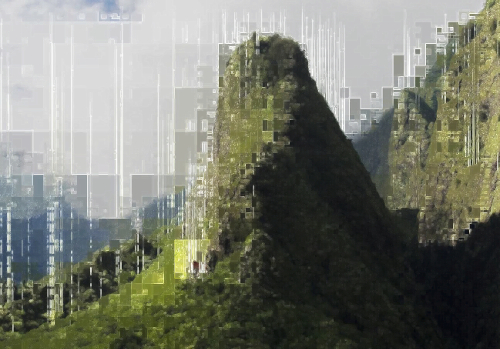
Figure 2: Mountain Shelter – Heath Rezabek
The sun was a golden haze, settling down upon this shambles by the sea. Near, inside a pilgrim’s shelter, Mentor Kaasura nodded at last light as it draped over hills and low roads, long since overgrown.
He had been seated there for much of the afternoon, sheltering from skittish rains. Before him, not far as a man might hike, lay the nameless, ruinous complex. Rusting generators brooded; breached coolant towers numbly gaped at the tumbling forest which scaled Iron Mountain to their west; behind their backs grey waves heaved and raked indifferently at the remains of its foundations.
None had lived here, or anywhere near these sleeping, vacant forms, for several generations; yet not far away, these timber shelters remained, small shadows crouching on the paths which faded into the hills. These leaning structures, maintained as they were by pilgrims of several sorts, each hosted a strange assortment of stowed and forgotten things.
Some of these were maps, through dreamlands now believed to be exposed here. Some were meditative texts, guiding the mindful reader towards countless branching worlds. And some were simply manuals on how to move through wilderness or doubt in a feral world.
But Mentor Kaasura had come in here clear of mind, free from fear, and had found this particular lean-to in the way he still recalled. Slowly stalking up the hillside, as the path around him crumbled into overgrowth and tussock, he had passed from shade to shade while lining up the old wayfinding beacons with ones more distant, until they drew a line upon which the distant Oiinu Arcology seemed to balance like a domed and lidded platter. And then, hardly needing to turn to enter the door, he sat to begin his meditations.
Clear and distant, a voice from before: ~If you go there, you’ll never return.~ His sister’s entreaty had seemed dismissive at the time, but hearing it again, through the lens of all their time before, he could see it had been a simple observation. Seasons returned; people returned. But time could not be rewound. Though things returned, they did so changed. He too would return, but the part of him that made the pilgrimage would recycle itself transformed. And so Kaasura sat.
He was here to ponder cycles. Though years were stretched long now, and little seemed to change from day to day, he knew from his own Mentor that there once had been a time when upheavals had seemed constant. The means to shape the world had unfolded and enfolded those who’d lived through that time, leading on to many things; even, yes, the crumbled generators now sinking into the valley below. He was here to ponder the means by which cycles stretched and snapped short.
But he was also in this place because he knew that here, the veil that braced the delving deeps was worn thin; and that this particular shelter, hugging the ragged mountain wall behind him, was a secret feint, a camouflaged diversion. He knew that he sat before an opening driven deep into the mountainside; he could feel a flow of slow sentience flooding the hut, streaming outwards from far behind him, and he shivered on his stump.
He could hear it just as well: a kind of sighing, or so he imagined. And so with eyes closed, to set imaginings aside, he began the traditional meditation on what still was called mortality; he saw himself standing out upon the road, then turning around to face the hut and him within it, standing firm as he gazed at the shelter, the brooding clouds above, the whispering shoots that crowded on all sides; and he saw himself clearly, seated there, facing out, eyes still shut.
And reaching down, as gently as he could, he took from his imagining hands a small and shimmering shard of knotted light, and bowed.
Stepping then beyond himself to enter this collapsing roof of a room, he faced the rear wall’s faded hanging, woven dense with interlacing. Beyond, he knew, lay the narrow channel through its iron-laden stone, walls dense with carven alcoves, splaying inwards into countless caverns and rivulets and grottos.
Mentor Kaasura paused, watching his outbreath. He committed to memory as much as he could of the tapestry’s patterned weave. Then blinking, his checkpoint saved, he stepped within.
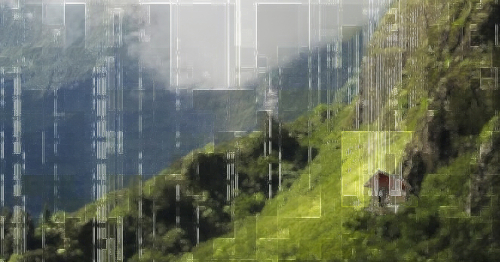
Figure 3: Mountain Shelter (Detail) – Heath Rezabek
– – –
By the mid-21st century, Project Avatamsaka had yielded the most robust synthetic mind ever conceived. To that point, swarm AI had shown some promise, and conscious aggregate drone-clouds had several times surmounted emergency response situations which had left other systems dismayed. Newer and greater challenges had in time sparked the rising of new minds to meet them.
Avatamsaka was different. For this system had to lend spirit to a starship, with all the agency that implied. Design decisions had been made which only in hindsight could be seen as more than the sum of their parts.
Avatamsaka presented itself as a unitary consciousness, though not always as the same one. Depending on the approach of the crew member, Avatamsaka could appear as either female or male, and to varying degrees; its range of personalities would waver when first approached, until settling into a fairly stable persona while dealing with any one person. The logician would confront a transcendent algorithm. The vain would confront an inscrutable foil. And the dreamer would stand face to face with an imagination unending.
This kaleidoscopic impact was not entirely by design: the mind had been built to stay adaptive, and couldn’t have been otherwise, but the scale of adaptation was wholly unplanned and had come from Avatamsaka hirself.
Hir central core was not unique; there were copies and backups in various places, each a singular starting point for sentient aggregation. Like seeds, data cores could be planted within a digital mesh, and would bloom from within. These simple seeds had come from another project altogether, but as Project Avatamsaka had worked itself up to speed, it was seen that the one could easily benefit the other.
Each cubic lattice was called a Vessel cache, and their sizes varied greatly. Though they appeared quite the opposite, at simplest any one of these cores could be modeled as a black box. The outside world went in, and was drawn back out in fragments, glimpses, sketches, connections found between the elements emerging and new wholes reassembled on the fly.
In this way, it turned out to make an excellent foil for the pattern-finding at which Avatamsaka excelled.
The basic process of concept discovery and reconstruction was called pattern-sampling (or patterning), and could be experienced (in principle) as a kind of a game. Thus:
– Take your nearly-infinite deck of cards, with nearly-infinite things on them. This is your Vessel.
– Draw any number of samples. (Let’s say 5.)
– Identify just over half of them as most readily related or relatable. (Let’s say 3.)
– Discard the outliers. The remaining set is your glimpse of knowledge, your pattern-sample. Do with it what you will.

Figure 4: Pattern Sample – (public domain elements)
– – –
The ultimate aim was for Avatamsaka to use these sets to perform all the tasks and functions of a living lightsail starship. For a starship on an extended voyage, the tasks are many, and most of them are mission-critical as the time window for potential failure is so wide. But among these tasks, one of the less critical yet more complex was the augmentation of reflexive dreamworlds for the crew to experience during the voyage. “Crew” was an interesting term by the time the four ships called Saudade set sail. Certainly, what amounted to petri dishes outnumbered the astronauts. A minority of the crew was what we would have called human, and most of those people were people by choice.
——-
The Avaai had chosen to remain in human form, albeit an optimized one. If there had been a reason, these crew in theory could have navigated the actual physical spaceframe of Saudade IV. But there were also a slim few, who had chosen to be set into stasis entirely, as their bodies were barely augmented at all. These were the Ghemaai, and their choice would have been a tremendous burden had they not been an archival decision in the first place.
As things stood, they were no more a burden in their hibernating forms than the tanks of lastline biomass sampled from Earth’s biomes. And like their wild kin, even in their stasis, the Ghemaai could dream.
Or delve, as the term was. This state was unlike what we’d have recognized as dreaming, as much of the source material for these inner lives was drawn from the nearly-infinite stores of the Vessel cache by Avatamsaka, vented in pattern-samples to the nervous systems of all who slept, whether Avaai or Ghemaai.
When the nearly-infinite range of pattern-sampled impressions contained within a Vessel cache was blended with the nearly-infinite intuitive capacities of a sentient being, novel things happened. For the purposes of the crew of the Saudade IV, the most novel of these was the simple fact that through these means, generations of lives could be lived out in seeming, in complete immersion, flowing starwards through space.
One of the family lines enmeshed in this way bore the last name of Ramer. But only one of the lightsails in the first fleet bore those folk as crew or cargo, and as you may have guessed by now, this was Saudade IV. We can guess that there were at least four such craft in that fleet; but we can’t know if there were more, or where this leaves the other three.
~We can’t even know if there truly were three others to start with~ mused Odiah Ramer, when first he thought it through. But he was delving deep in the weave of the Avaai at the time, and before the lesson arcs had been patterned to guide fretful minds, this place was a disorienting place to be.
– – –
Somewhere in spacetime, Avatamsaka glides through the depth between stars, clad only in a lightsail named Saudade.
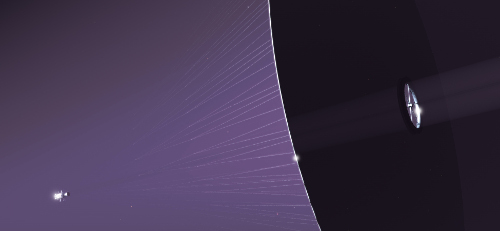
Figure 5: Sailship (Detail.) – Adrian Mann. (Used by Permission.)

Shaking Up a ‘Snow Globe’ Solar System
The same issue of Nature that carried Ian Crossfield’s weather map of Luhman 16B, published yesterday, also featured a paper from Francesca DeMeo on planetary systems in chaos. Specifically, DeMeo (a Hubble postdoctoral fellow at the Harvard-Smithsonian Center for Astrophysics), looks at main belt asteroids in terms of their composition and history. Her findings reveal an early system nothing like the relatively sedate situation we see today, with small, rocky worlds near to the Sun and gas giants on much more distant orbits.
Indeed, the migration of giant planets produced what DeMeo likens to “flakes in a snow globe” as asteroids were disrupted and interplanetary debris was thrown into new trajectories. The dynamical processes thus unleashed may have played a huge role in Earth’s development.
Working with data from the Sloan Digital Sky Survey, DeMeo teamed with Benoit Carry (Paris Observatory) to chart more than 100,000 asteroids throughout the Solar System, finding that especially among the smaller objects in the main belt, the diversity is much more pronounced than astronomers had realized. A simple progression from wet to dry as asteroids get closer to the Sun appears to be ruled out, and so-called ‘rogue’ asteroids — ones that formed in a dry environment and are now beyond the snow line, for example — may be more common than previously thought, an effect that is most evident in the population of smaller asteroids.
“It’s like Jupiter bowled a strike through the asteroid belt,” says DeMeo. Everything that was there moves, so you have this melting pot of material coming from all over the solar system.”
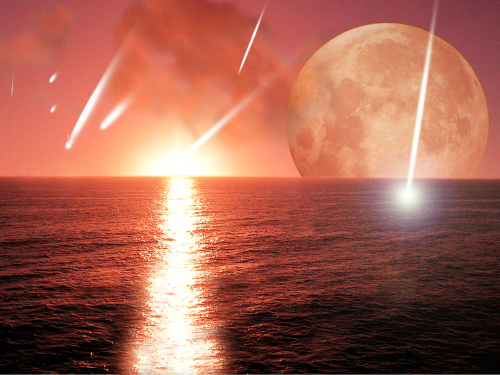
Image: Astronomers have theorized that long-ago asteroid impacts delivered much of the water now filling Earth’s oceans, as shown in this artist’s conception. If true, the stirring provided by migrating planets may have been essential to bringing those asteroids into play. Credit: David A. Aguilar (CfA).
Planetary migration may have brought Jupiter as close to the Sun as Mars is now, scouring the asteroid belt to leave little more than a tenth of one percent of its original population. Such migrations would have stirred the entire system, so that objects collected in the asteroid belt with origins as varied as close solar orbits to the distant realm of Neptune. And if this is the case, this shake-up of interplanetary materials may have delivered much of the water found in today’s oceans to Earth. This may be a key mechanism for bringing volatiles from beyond the snow line to warm but dry rocky worlds as planets capable of supporting life emerge elsewhere.
The paper is DeMeo and Carry, “Solar System evolution from compositional mapping of the asteroid belt,” Nature 505 (30 January 2014), pp. 629-634 (abstract).

Focus on the Nearest Brown Dwarfs
Luhman 16AB (otherwise known as WISE J104915.57-531906) holds out quite an allure for those of us hoping to see future exploratory missions to nearby interstellar space. As recounted here in December (see Possible Planet in Nearby Brown Dwarf System), the European Southern Observatory’s Henri Boffin has found that this brown dwarf pair is likely home to a previously undetected companion. Bear in mind that we know of no closer brown dwarf; indeed, Luhman 16AB is no more than 6.6 light years out, making it the third closest system to our Sun after Barnard’s Star and, of course, Alpha Centauri.
We know very little about this putative companion other than Boffin’s estimate that its likely mass is between a few Jupiter masses and perhaps as many as 30, but the good news is that the high end of this mass range should offer us an object that can be detected by adaptive optics, given the size of the apparent separation. In any case, radial velocity methods should work nicely here as well, given that as seen from Earth, the brown dwarf pairing appears nearly edge-on.
Now comes further news from the European Southern Observatory, with the announcement that one of the two brown dwarfs, Luhman 16B (WISE J104915.57-531906.1B) shows variations in brightness as it rotates, giving us strong hints of detectable features in its atmosphere. Using ESO’s Very Large Telescope, a team of researchers has mapped out the light and dark areas on Luhman 16B, observing the brown dwarf pair with the CRIRES instrument on the VLT (CRIRES is a high-resolution infrared spectrograph). The resulting ‘map’ appears below.
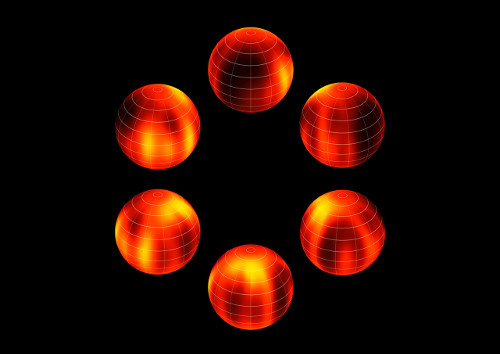
Image: ESO’s Very Large Telescope has been used to create the first ever map of the weather on the surface of the nearest brown dwarf to Earth. An international team has made a chart of the dark and light features on WISE J104915.57-531906.1B, which is informally known as Luhman 16B and is one of two recently discovered brown dwarfs forming a pair only six light-years from the Sun. The figure shows the object at six equally spaced times as it rotates once on its axis. Credit: ESO/I. Crossfield.
Ian Crossfield (Max Planck Institute for Astronomy) is lead author of the paper on this work, which will appear in Nature:
“Previous observations suggested that brown dwarfs might have mottled surfaces, but now we can actually map them. Soon, we will be able to watch cloud patterns form, evolve, and dissipate on this brown dwarf — eventually, exometeorologists may be able to predict whether a visitor to Luhman 16B could expect clear or cloudy skies.”
‘Exometeorologist’ — yet another new job description spawned by this golden age of exoplanetary exploration!
You can see where this is heading. As we learn more about the weather patterns on brown dwarfs, we are moving toward theoretical models which can be tested against future observations. When next-generation telescopes like the European Extremely Large Telescope come online, we can anticipate eventually creating similar maps for young gas giants. In none of these worlds should we expect clement weather: The clouds Crossfield’s team detected show temperatures in the range of 1100 degrees Celsius and are likely carrying droplets of molten iron and various minerals adrift in an atmosphere made up largely of hydrogen.
Crossfield’s map is complemented by a second study led by Beth Biller (University of Edinburgh), which observed brightness variations at different wavelengths in an attempt to understand what happens in various layers of the atmosphere on both Luhman 16A and 16B. This team drew its data from the 2.2 meter telescope at ESO’s La Silla observatory in Chile. Measurements were made in seven different filter bands, where emissions are correlated with the temperature of the emitting gas. Thus the different wavelengths probably represent layers at different depths within the brown dwarf’s atmosphere, constituting a kind of atmosphere probe.
The resulting paper appears in Astrophysical Journal Letters. According to this MPIA news release, this investigation marks the first simultaneous monitoring of a brown dwarf’s brightness variability in more than two wavelength ranges. Says Biller:
“We’ve learned that the weather patterns on these brown dwarfs are quite complex. The cloud structure of the brown dwarf varies quite strongly as a function of atmospheric depth and cannot be explained with a single layer of clouds.”
So we wind up with brown dwarfs with multiple cloud layers and/or temperature variations as we push ahead with the effort to understand weather patterns in distant solar systems. Keep in mind we are dealing with a place that is only slightly farther from the Earth than Barnard’s Star. If the companion object is eventually confirmed as a planet, Luhman 16AB will have the second closest exoplanet to Earth yet detected (assuming Centauri Bb is also confirmed). It will be an exciting period ahead as we try to learn what other objects may circle the nearest stars.
The mapping of Luhman 16B is described in Crossfield et al., “A Global Cloud Map of the Nearest Known Brown Dwarf,” about to appear in Nature (30 January 2014). See this ESO news release for more on that finding. Beth Biller and team’s work is found in Biller et al., “Weather on the Nearest Brown Dwarfs: Resolved Simultaneous Multi-Wavelength Variability Monitoring of WISE J104915.57-531906.1AB” in Astrophysical Journal Letters, Volume 778, Issue 1, L10.

An Intergalactic River of Hydrogen?
NGC 6946, the so-called ‘Fireworks Galaxy,’ has caught the eye of many an astronomer, even if its position — close to the plane of the Milky Way and thus partially obscured by gas and dust — makes the observation difficult. At 22 million light years from Earth, this face-on spiral galaxy has been the site of eight supernovae in the past century. I’m thinking about supernovae because SN 2014J, a supernova a scant 12 million light years away in M82, has been much in the news in recent days. But NGC 6946 is also intriguing because of the active pace of star formation there. What sustains a galaxy like this and keeps its star formation robust?
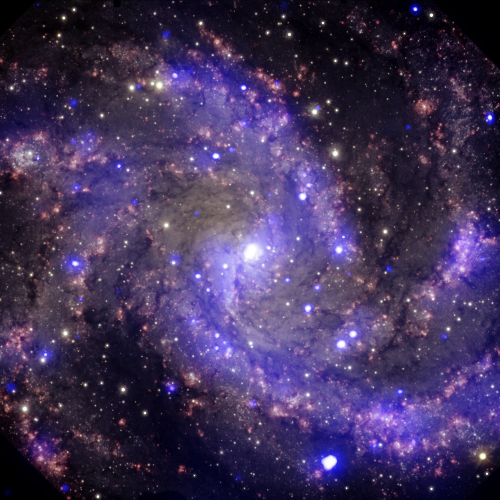
Image: The spiral galaxy NGC 6946. Observations from the Chandra spacecraft have revealed three of the oldest supernovas ever detected in X-rays here. This composite image also includes optical data from the Gemini Observatory in red, yellow, and cyan. Credit: X-ray: NASA/CXC/MSSL/R.Soria et al, Optical: AURA/Gemini OBs.
Now D. J. Pisano (West Virginia University) has discovered what appears to be a flow of hydrogen through intergalactic space, a gaseous filament streaming into NGC 6946 that can explain its active engine of star formation. Pisano puts the find in context:
“We knew that the fuel for star formation had to come from somewhere. So far, however, we’ve detected only about 10 percent of what would be necessary to explain what we observe in many galaxies. A leading theory is that rivers of hydrogen – known as cold flows – may be ferrying hydrogen through intergalactic space, clandestinely fueling star formation. But this tenuous hydrogen has been simply too diffuse to detect, until now.”
Galaxies where the rate of star formation is highest are known as ‘starburst’ galaxies, their activity considered a phase of the galaxy’s evolution. M82, site of the recent supernova, ranks as one of these. NGC 6946 can’t claim that level of activity, but the galaxy — found in the night sky between the constellations Cepheus and Cygnus — is a good deal more active than our relatively sedate Milky Way. And while an extended hydrogen halo has previously been observed in NGC 6946, the likely result of intense star formation and supernova explosions, what Pisano has discovered comes from a different source — intergalactic space.
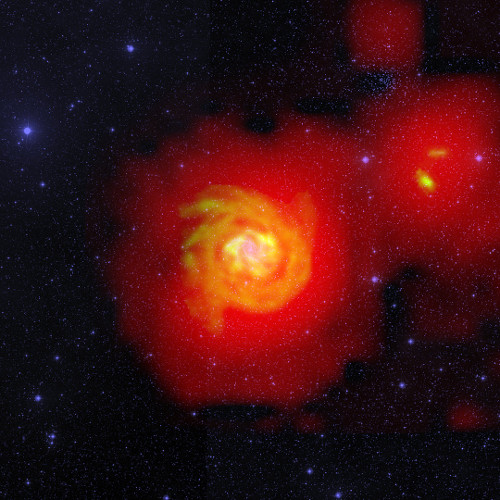
Image: This composite contains three distinct features: the bright star-filled central region of galaxy NGC 6946 in optical light (blue), the dense hydrogen tracing out the galaxy’s sweeping spiral arms and galactic halo (orange), and the extremely diffuse and extended field of hydrogen engulfing NGC 6946 and its companions (red). The new GBT data show the faintly glowing hydrogen bridging the gulf between the larger galaxy and its smaller companions. This faint structure is precisely what astronomers expect to appear as hydrogen flows from the intergalactic medium into galaxies or from a past encounter between galaxies. Credit: D.J. Pisano (WVU); B. Saxton (NRAO/AUI/NSF); Palomar Observatory – Space Telescope Science Institute 2nd Digital Sky Survey (Caltech); Westerbork Synthesis Radio Telescope
Working with the Green Bank Telescope, Pisano was able to uncover the signature of neutral hydrogen gas that had eluded other instruments. A steady flow of cold hydrogen could explain why larger galaxies are able to maintain their activity as they draw star-forming material from less massive neighbor galaxies. But Pisano can’t rule out the possibility that the gaseous fields shown in the image above could also be the result of an encounter with another galaxy in the distant past, one that left a ribbon of star-forming hydrogen behind. From the paper:
The best way to identify cold flows is statistically via a large survey. Cold flows should preferentially exist around low mass galaxies in low density environments. Tidal debris, on the other hand, should exist preferentially around galaxies in high density environments. Galactic outflows should preferentially exist around galaxies with low masses and large star formation rates. The ideal H I survey would span a wide range of galaxy mass, environment, and star formation rates to discriminate between these different origins.
Such a survey is precisely what Pisano now has in progress, with results to be announced in the near future. Given that the observed rate of hydrogen accretion in nearby galaxies is only ten percent of what would be needed to maintain star formation, we have a lot to learn about how galaxies sustain themselves. The work has also identified an extended disk around the galaxy NGC 2997 and its satellite galaxies, but no filamentary structures of the kind found at NGC 6946, where the hydrogen flow is evidently connected with the nearest satellite galaxies.
The paper is Pisano, “Green Bank Telescope observations of low column density HI around NGC 2997 and NGC 6946,” Astronomical Journal Vol. 147, No. 3 (2014), p. 48 (preprint / abstract).

